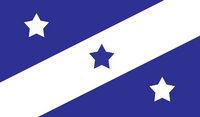West Florida

| |
| Subdivision of: | The North American League |
| Capital: | Pensacola |
| Official Languages: | English, Castilian |
| Established: | 1705, Division of Florida |
| Admission to NAL: | 1803 (12th) |
| Readmission to NAL: | 2004 |
La Florida Occidental, or West Florida in English, is a province of the NAL, and formerly under NAL military occupation following the Florida War of 2004. Its borders are the Perdido River on the west, the Appalachicola River on the east, and the 31st parallel on the north. It has a history of over 4 centuries. It consists of the former Florida-Caribbean distritos of Pensacola and Bahía de San Andrés.
Administration
Administrative Divisions
West Florida is divided into 9 distritos
- Pensacola
- Escambia
- Río Amarillo
- North Choctahachi
- South Choctahachi
(These five were formed from the FC Distrito de Pensacola)
- Panama
- Apalachicola
- Naranja
- Seminole
(These four were formed from the FC Distrito de la Bahía de San Andrés)
History
First Castilian Period (1559-1705)
The history of Castilian rule in West Florida begins in 1559, when the city of Pensacola was first founded. It was destroyed several years later in a hurricane and later rebuilt. Locals often consider Pensacola to be North America's oldest European city because of the first settlement. Pensacola is today known as the City of Six Flags for the flags of the six nations that have flown over it throughout its history, Castile and Leon, England, France, the NAL, the brief Republic of West Florida (see below), and Florida-Caribbea.
Western Florida was largely neglected during this period. In 1702, the English captured Pensacola, formally taking control of northern Florida in 1705.
English Period (1705-1803)
After taking control of Florida, England divided it into two halves, West Florida, governed from Pensacola, and East Florida, governed from San Augustín (which had formerly been the capital of all of Florida). They also moved the northern border of West Florida up to a line stretching from the mouth of the Yazoo River to the Chattahoochee (32°28'). Several years later, the Castilians founded a settlement at Tampa Bay, and claimed the southern part of the peninsula as La Florida del Sur (South Florida), from the 29th parallel down. Pensacola began to grow as an important port and administrative center. The English began an intensive program of developing the Floridas and attracting settlers, filling the Floridas with English colonists. The western border originally stretched as far west as Mississippi. Border disputes between England and France over the exact western limit of West Florida, which included a brief capture of Pensacola by the French in 1719, were settled in the Pearl River Treaty, which established the Pearl River as the border between West Florida and Louisianne.
First NAL Period (1803-1819)
In 1803, East and West Florida became founding members of the NAL. The NAL period did not last long. In 1806, Castile invaded, annexing the Floridas. Cherokee Nation helped West Florida preserve some of their territory. The eastern part of that territory was sold to Cherokee Nation, and the western half eventually became modern-day Mobile Province. The first NAL period is considered to have officially ended in 1819, when "English West Florida" renounced its claims to the Castilian-occupied region.
Second Castilian Period (1806-1898)
Between 1806 and 1898, West Florida was again part of the Castilian Empire. The Castilians continued the English-started program of developing the Floridas. Northern Florida in particular remained heavily English-speaking. In 1819, the territory west of the Perdido was sold to the NAL, further diminishing Castilian West Florida. In 1898, the Floridas broke away from Castile.
República de la Florida Occidental (1898-1900)
The Republic of West Florida was a brief entity, existing from 1898, when independance from Castile was recognized, until 1900, when it became part of the República Nacionalista y Revolucionista de las Floridas. There had been talk of seeking readmission into the NAL, but closer relations with East and South Florida won out.
Florida-Caribbea (1900-2004)
West Florida merged with East and South Florida to form the Republic of the Floridas (full name: La República Nacionalista y Revolucionista de las Floridas) in 1900. See Florida-Caribbea for more details. During this period, the north became increasingly neglected, and secessionist movements developed in the former NAL provinces of East and West Florida, aimed at returning to the NAL. These movements were crushed, and went underground. In the 1970's, the territory west of the Perdido was reannexed by FC (who also dreamed of reannexing the land south of the 32°28' line). West Florida was liberated in 2004 after the Florida War
Second NAL Period (2004- )
After the Florida War, a provisional government was instituted in West and East Florida. On 5 July, 2004, the people of West Florida, along with East Florida, approved a referendum asking for provincial status. This was approved on 30 July. The formal readmission occured early in 2005. West Florida was numbered 33 in order of admission.
Geography
West Florida borders Cherokee Nation to the north and west, the Gulf of Mexico to the south, and Jacobia and East Florida to the east